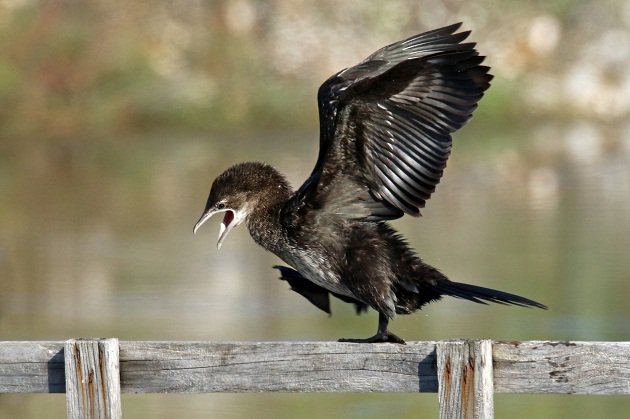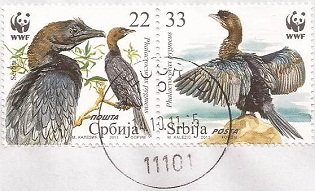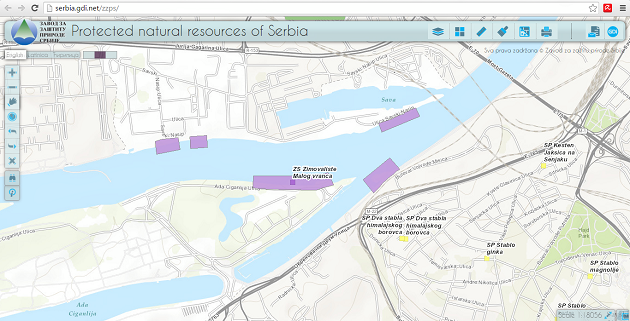
Worried by the lack of appropriate action by the authorities (as described in the previous post), this year I invited two more wildlife protection organisations to take part in the annual census of Pygmy Cormorants in Belgrade. Here is a joint media release:
WWF, Decembar 11, 2015 – This December, 3,800 Pygmy Cormorants are wintering by the river Sava in Belgrade, Serbia, representing 2 percent of the global population and 5.4 percent of their European population. The census has been conducted by ornithologists from three NGOs, BPSSS/BirdLife Serbia, League for Ornithological Action and the World Wildlife Fund. This year’s results are 24 percent lower than last year’s, when 5,000 birds were recorded, but their presence still shows great value and importance of the river habitat in the inner city area.
“The Pygmy Cormorant is a strictly protected bird species in Serbia, as well as in the European Union. It belongs to a group of species of special conservation concern, which under the European Birds Directive requires Member States to designate Special Protection Areas (Annex I species). It is estimated that the total European population is 28,000 to 39,000 breeding pairs. As a waterbird, it is threatened by destruction and draining of aquatic habitats”, said Goran Sekulic on behalf of the Bird Protection and Study Society of Serbia.
 During the day, Pygmy Cormorants mainly feed on the Sava, Danube and other major bodies of water in the area, and in the evening they gather in flocks and roost in small willow stands along the Sava in large groups. They are choosing specific locations with willow trees located right by the water. The most important roosting site for Pygmy Cormorants is near the bridge on Ada.
During the day, Pygmy Cormorants mainly feed on the Sava, Danube and other major bodies of water in the area, and in the evening they gather in flocks and roost in small willow stands along the Sava in large groups. They are choosing specific locations with willow trees located right by the water. The most important roosting site for Pygmy Cormorants is near the bridge on Ada.
“At this point, we still cannot pinpoint the exact cause of the reduced number of Pygmy Cormorants in Belgrade. The reason for the decrease in their numbers this year may be the warm autumn and their slow gathering on the wintering grounds, or it may have something to do with fluctuation in population numbers. The fact that 2% of the world population of this species spends the winter in our capital is significant, but does not mitigate a lot of my concerns about the decline in their numbers and the necessity to fight for permanent protection of small willow stands, their roosting place on the Sava. By protecting their natural wintering grounds, we protect Pygmy Cormorants from further decline and ensure the survival of the largest urban wintering grounds for this attractive species in the world”, said Dragan Simic, on behalf of the League for Ornithological Action.
The construction of the bridge at Ada destroyed one of the small willow stands in which Pygmy Cormorants roosted. Fortunately, the birds endured the loss of habitat relatively well and there hasn’t been a drastic decrease in numbers. Because of the vulnerability of the small number of remaining willow stands that Pygmy Cormorants use, their protection was initiated. The Institute for Nature Conservation of Serbia, in cooperation with the Belgrade Land Development Public Agency and the League for Ornithological Action produced a study for protection of five locations on the left and the right banks of the Sava around Ada Ciganlija Island. The study was prepared in 2012, but no protection has been declared to date.

“The Pygmy Cormorants continue to resist high pressures and threats to which they are exposed in the urban area of Belgrade, but their survival in this area is fully dependent on the protection of remaining isolated small willow stands on the banks of the Sava. Urgent proclamation and establishment of protected habitats for Pygmy Cormorant is neccessary in order to preserve this exceptional natural value. That is why we support the appeals of the League for Ornithological Action and the Bird Protection and Study Society of Serbia towards the competent institutions to pass the act on the protection of the area and prevent the loss of Pygmy Cormorant’s habitat, which has prevailed in the heart of the city for decades, as soon as possible”, said Sonja Badjura in the name of the WWF program in Serbia.
Between 900 and 1,600 pairs of this species breed in Serbia, mainly in the north. For more than 10 years during which the League for Ornithological Action has been following the Pygmy Cormorants in Belgrade, the maximum number was recorded in the winter of 2007/2008, when the population counted 6,750 individuals. This figure represents almost 10 percent of the total European population, which speaks about the great importance of the Sava riverbanks, in the heart of a capital city, for the conservation of biological diversity, which has an importance that transcends national borders. The distribution of this species is limited to South-Eastern Europe, the Middle East and the area around the Black and the Caspian Sea in western Asia.
Cover photo (c) by Maciej Szymanski













Thank you for the work you are doing to protect these endangered birds
Thank you, Lorena. My two decades long counting surely improved our knowledge of them, but how much did I actually helped them?
I don’t know – they are resilient little survivors